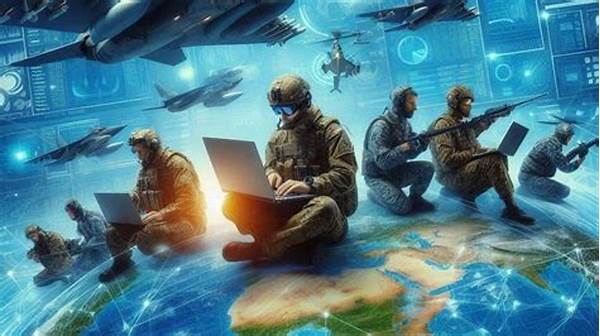The Importance of Multinational Defense Technology Sharing
In an era characterized by rapid technological advancements and evolving security threats, multinational defense technology sharing has emerged as a crucial aspect of modern defense strategies. Countries around the globe recognize the necessity to collaborate and share technological innovations to address common security challenges efficiently. This form of cooperation not only enhances national security but also promotes global stability by creating a united front against potential threats.
Multinational defense technology sharing involves the exchange of advanced technological solutions, expertise, and resources among nations. By merging capabilities, countries can develop more sophisticated defense systems, optimize resource allocation, and minimize the duplication of efforts. Furthermore, this practice fosters trust and strengthens alliances, as sharing sensitive technology requires significant levels of mutual understanding and confidence. Thus, multinational defense technology sharing is integral to fostering peace and security in an increasingly interconnected world.
Enhancing Security Through Collaboration
1. Global Alliances Strengthening: Multinational defense technology sharing enhances global alliances by fostering trust and collaboration. It lays the groundwork for cooperative defense initiatives, allowing countries to pool resources for mutual benefit.
2. Resource Optimization: By collaborating on defense technology, countries can optimize resource allocation and funding. This ensures that technological advancements are efficiently developed and integrated into defense systems, reducing redundancies.
3. Technological Advancements: Shared expertise accelerates technological innovation by combining skills and knowledge. Multinational defense technology sharing leads to the development of cutting-edge solutions, addressing diverse security challenges effectively.
4. Standardization: Multinational defense technology sharing promotes standardization across allied nations. This ensures interoperability of defense systems, facilitating seamless cooperation in joint military operations.
5. Strengthened Deterrence: By presenting a united front through shared technology, nations can bolster deterrence against potential aggressors. Multinational defense technology sharing projects strength and unity, making hostile actions less likely.
Challenges in Multinational Defense Technology Sharing
Despite its benefits, multinational defense technology sharing faces several challenges. One significant hurdle is the protection of intellectual property rights, which can complicate the sharing process. Countries must navigate legal frameworks and address concerns about the unauthorized dissemination of sensitive technologies. To overcome these challenges, clear agreements and stringent security measures must be put in place to safeguard shared information.
Moreover, geopolitical tensions can influence the willingness of nations to share technology. Political differences or conflicting interests may hinder cooperation, limiting the effectiveness of multinational defense technology sharing. Therefore, diplomatic efforts must be employed to build trust and alleviate concerns, ensuring that technological collaboration is maintained even amidst international disagreements.
Overcoming Barriers to Multinational Defense Technology Sharing
To maximize the potential benefits of multinational defense technology sharing, nations must adopt strategies to overcome existing barriers. Establishing comprehensive legal frameworks that address intellectual property concerns is crucial in facilitating technology exchange. Additionally, developing clear communication channels among participating countries can ensure transparency and foster collaboration.
Security measures must be enhanced to protect sensitive information from unauthorized access. This includes robust cybersecurity protocols and secure information-sharing platforms. Moreover, countries should engage in continuous diplomatic efforts to maintain strong bilateral and multilateral relationships, addressing any geopolitical tensions that could impede collaborative initiatives. Through these approaches, nations can create a conducive environment for successful multinational defense technology sharing.
Building a Framework for Global Defense Collaboration
Establishing a well-structured framework for multinational defense technology sharing is essential to harness its full potential. This involves creating joint research and development centers where nations collaborate on innovative defense technologies. Such centers can serve as hubs for innovation, allowing experts from various countries to work together on cutting-edge solutions.
Additionally, fostering academic and industry partnerships can promote the exchange of knowledge and expertise. By engaging with research institutions and defense companies worldwide, countries can tap into a broader pool of talent and resources. A cohesive framework that encourages these collaborations will not only advance defense technology but also strengthen international ties in the defense sector.
Cultivating a Harmonious Defense Ecosystem
A harmonious defense ecosystem, underpinned by multinational defense technology sharing, is essential for global security. By fostering a sense of community and shared purpose, countries can collaborate more effectively to address global security threats. This involves engaging in joint military exercises and training programs, promoting interoperability among defense forces.
Moreover, dialogue and communication are paramount in building a strong defense community. Regular meetings, conferences, and workshops can facilitate discussions on technology sharing practices and address emerging security challenges. A collaborative ecosystem ensures that nations remain proactive in their defense strategies, enhancing the overall resilience of global security architecture.
Summary: Fostering Global Defense Cohesion
In summary, multinational defense technology sharing plays a pivotal role in shaping global defense strategies. By enhancing technological collaboration, nations can address common security threats more efficiently and effectively. The exchange of technology and expertise not only optimizes resource allocation but also strengthens alliances and builds trust among nations.
Challenges such as intellectual property rights and geopolitical tensions must be addressed to maximize the benefits of multinational defense technology sharing. Through strategic planning, robust legal frameworks, and enhanced security measures, countries can overcome these barriers and create a conducive environment for collaboration. Ultimately, multinational defense technology sharing fosters a united front, enhancing global peace and stability in an increasingly interconnected world.





